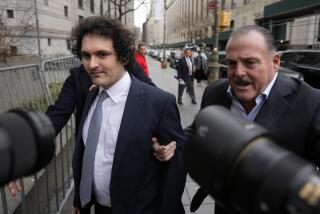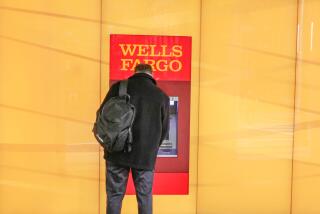No Quick Figuring for Investor Payback
- Share via
If you owned shares in a mutual fund that got spanked by regulators, you can look forward to a little piece of nearly $2 billion in restitution money.
Just don’t expect it to arrive before Christmas -- this year, or maybe even next.
Since the mutual fund scandal broke 13 months ago, federal regulators have struck settlements that will cost a dozen fund companies more than $2.8 billion. Of that, nearly $2 billion is earmarked for direct payments to investors.
But sorting out who gets paid, and how much, is a complex task that probably will take months, according to experts on the $7.5-trillion mutual fund industry.
The calculations will be performed by private consultants, who are to be hired by the mutual funds with the approval of the Securities and Exchange Commission.
“There’s a lot of math to be done here,” said Mark K. Schonfeld, director of the SEC’s Northeast regional operations and the agency’s leading expert on disbursements. “That’s something the consultants haven’t gotten to yet.”
Said Morningstar Inc. fund analyst David Kathman: “Patience is the keyword.” He said he hoped to see refunds “within a few months” from the fund companies that settled first, such as New York’s Alliance Capital Management. Alliance agreed in December to pay $250 million in restitution and fines for distribution to aggrieved shareholders.
Officials at the SEC, which is overseeing the paybacks, aren’t making public predictions of when shareholders may receive their money, speculating privately that it can take six to 18 months. The long end of that range would push some payouts well into 2006.
Whenever they arrive, the refunds probably will have little effect on investors’ net worth.
The seven Janus Capital Management mutual funds where misconduct occurred, for example, held $24 billion on Aug. 31. In its SEC settlement, Janus agreed to repay $100 million to shareholders of those funds -- an amount that if shared equally would return about $42 to someone with a $10,000 account, Kathman said.
The actual paybacks are expected to vary widely, depending on which funds the investors owned and whether they owned them on the dates that the shenanigans occurred.
“Some people invariably would get a lot less” than others, Kathman said, “maybe just enough to buy lunch or something like that.”
Mutual fund investors were alerted to potential problems when New York Atty. Gen. Eliot Spitzer accused the Janus funds, Bank of America Corp.’s Nations Funds, Banc One funds, and Strong Capital Management Inc. of cheating most customers to benefit a few.
The firms had permitted favored investors, notably the hedge fund Canary Capital Partners, to make after-hours trades in violation of law. They also had permitted certain investors to seek profits by engaging in “market timing,” or rapid-fire trading that violated the funds’ own policies. In return, Spitzer said, the favored few brought other fee-generating business to the mutual funds.
Since the scandal broke, 12 companies that operate funds have agreed to settle such improper trading cases brought by the SEC, Spitzer and other state regulators. The latest came Wednesday, when San Francisco-based RS Investments and two top executives agreed to pay $30 million -- $11.5 million in returned profits, $13.5 million in fines as well as $5 million in reduced management fees over the next five years, the SEC and Spitzer announced.
Several additional funds are expected to settle with regulators, analysts say, and a slew of class-action lawsuits, consolidated in federal court in Baltimore, could eventually add an unknown amount to shareholders’ recoveries.
The agreements with regulators include provisions that the fund managers disgorge improper profits, refund fees earned while the improper trading was taking place and pay hundreds of millions of dollars in fines.
That doesn’t mean anyone has figured out exactly how to allocate that money to ensure that fund shareholders get their fair share of the damages -- a surprisingly tricky task, analysts say. Indeed, according to SEC officials and a consultant to the funds, only two of the 11 funds have selected outside financial consultants to devise the distribution plans as required by regulators.
As an illustration of the complexities of the cases, Kathman noted that it took Denver-based Janus about seven months to announce a tentative agreement with federal authorities, Spitzer and Colorado’s attorney general. And it was nearly a year before the deal was finalized with the SEC.
In addition to the $100 million in fines and restitution Janus will pay-- money that under the Sarbanes-Oxley Act of 2002 will go to wronged investors -- it has agreed to cut its fees by $125 million over five years. More than $1 million also will go to Colorado regulators for investor education programs.
Janus spokeswoman Shelley Peterson said getting reimbursements to shareholders “is a very high priority for us.” The SEC settlement requires Janus to hire a payback consultant by Nov. 17 and submit a distribution plan to federal regulators by April 11, she said. The SEC would have to approve the plan before payments could be made.
Outside analysts said Janus’ case illustrates just how complicated the allocation of paybacks to shareholders could be.
Like other funds involved in the scandal, Janus didn’t admit any wrongdoing. But it also didn’t contest the facts recited in its settlement with the SEC, which said that between November 2001 and September 2003 it allowed 12 market timers “to trade far more frequently than other shareholders” in hopes of profiting on fluctuations in the market. Some of the timers were allowed “to make frequent trades of up to tens of millions of dollars,” the SEC said.
The $125 million in reduced fees will be spread among shareholders of all 67 Janus mutual funds over the five years. In an ironic twist, that means investors who cashed out their Janus holdings because of the trading scandal won’t enjoy that benefit.
The calculation of damages for shareholders in the seven funds directly affected by improper trading will be far more complicated, said Alan Friedman, vice president of Charles River Associates Inc. in New York, a financial consulting firm. Friedman said he had studied the matter for several of the mutual funds involved in the trading scandal, but declined to identify which ones.
Two components of the $1.9 billion in direct paybacks -- fines and returned management fees -- probably could be spread proportionately among shareholders in the seven funds at the time the trading abuses occurred, Friedman said. In a relatively simple adjustment, those payments would be reduced for investors who owned the funds only part of the time.
Calculating how to allocate damages to shareholders is tougher, Friedman said, because market timing can affect funds differently at different times. Factors such as delays in executing trades, or whether the prices of securities in the funds are rising or falling, can mean that funds lose larger or smaller amounts -- or even come out ahead because of market timing transactions, he said.
To be precise, a damage analysis would have to account for the effect of each timing transaction on every affected fund, then allocate the losses or gains among shareholders on a daily basis -- something Friedman said requires powerful computer programs.
As a result, shareholders with holdings of a similar size could receive back sharply different amounts depending on which funds they invested in, and when.
“These are not calculations that investors can work out at home,” Friedman said.
The good news for affected fund shareholders is that they generally don’t have to do anything but wait for the funds to contact them about refunds, said Morningstar’s Kathman. This will occur only after the consultants come up with a distribution plan, get the plan blessed by the fund company and the SEC and perhaps evaluate comment from additional interested parties as well.
Among the details that the consultants will consider are whether some shareholders can be reimbursed by adjusting their accounts, instead of getting restitution checks, and whether to set a minimum level of loss to qualify for reimbursement.
Some shareholders will want to actively pursue additional information, however.
“I’m sure it couldn’t hurt for people to contact the fund company, especially if they’ve since sold the fund, or moved,” Kathman said.
Contacting the SEC won’t do much good, “since they’re not the ones keeping track of who owned which funds when,” he said.
* (BEGIN TEXT OF INFOBOX)
Investor paybacks To settle charges of trading abuses, these companies are refunding money to shareholders and slashing fees for a five-year period. In addition to these payouts, some funds are also paying fines to state regulators that are not passed on to investors.
Payment to Amount of shareholders fee reduction Fund company (millions) (millions) Amvescap* $375 $75 Alliance Capital Management 250 350 Bank One 50 40 Bank America/ FleetBoston** 515 160 Franklin Templeton 50 none Janus 100 125 Massachusetts Financial 225 125 Pilgrim Baxter 90 10 Pimco 50 none Putnam Invest 60 none RS Investment 25 5 Strong Capital 80 35
*Includes Invesco and AIM fund settlements. **Bank of America acquired FleetBoston in March; includes Nations and Columbia fund settlements.
Source: Times research
More to Read
Inside the business of entertainment
The Wide Shot brings you news, analysis and insights on everything from streaming wars to production — and what it all means for the future.
You may occasionally receive promotional content from the Los Angeles Times.











